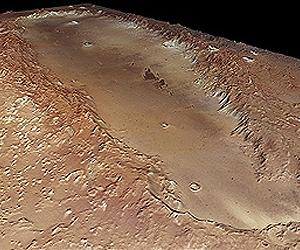|
 Orcus Patera - Mars's Mysterious Elongated Crater
Orcus Patera - Mars's Mysterious Elongated CraterBonn, Germany (SPX) Aug 30, 2010 Orcus Patera is an enigmatic elliptical depression near Mars's equator, in the eastern hemisphere of the planet. Located between the volcanoes of Elysium Mons and Olympus Mons, its formation remains a mystery. Often overlooked, this well-defined depression extends approximately 380 by 140 kilometres in a north-northeast to south-southwest direction. It has a rim that rises up to 1800 metres above the surrounding plains, while the floor of the depression lays 400 to 600 metres below the surrounding ... read more |
. |
|
|
Free Space, Earth, Energy And Military Newsletters - Delivered Daily |
| . | . |
| .. |
Opportunity Stops To Check Out Rocks Pasadena CA (JPL) Aug 27, 2010
Pasadena CA (JPL) Aug 27, 2010Opportunity has paused in her trek toward Endeavour crater to examine an exposed outcrop of rock that is of interest to the science team. On Sol 2336 (Aug. 19, 2010), the rover performed a 7-meter (23-foot) backward turn with a forward bump to approach the outcrop contact. On the next sol, Opportunity performed a short turn to place surface targets within reach of the robotic arm (Instrume ... more Some Asteroids Live In Own Little Worlds  Boulder CO (SPX) Aug 26, 2010
Boulder CO (SPX) Aug 26, 2010While the common perception of asteroids is that they are giant rocks lumbering about in orbit, a new study shows they actually are constantly changing "little worlds" that can give birth to smaller asteroids that split off to start their own lives as they circle around the sun. Astronomers have known that small asteroids get "spun up" to fast rotation rates by sunlight falling on them, mu ... more Ready for 'Danes in Space'?  Copenhagen, Denmark (UPI) Aug 24, 2010
Copenhagen, Denmark (UPI) Aug 24, 2010 Astronauts, cosmonauts and even Chinese Sinonauts may soon have company in space, two Denmark engineers say - so get ready for the Danonauts. Self-employed engineers Kristian von Bengtson and Peter Madsen are preparing a test launch their hand-built Hybrid Exo Atmospheric Transporter, or HEAT 4 rocket, from a barge off the wind-swept Danish island of Bornholm before mid-September, Brit ... more |
.. |
 Richest Planetary System Discovered  NASA prepares for asteroid rendezvous  Instant online solar energy quotes Solar Energy Solutions from ABC Solar |
.. |
|
|
Free Space, Earth, Energy And Military Newsletters - Delivered Daily |
|
|
. |
 Astronauts' brains 'tricked' for training
Astronauts' brains 'tricked' for trainingHouston (UPI) Aug 24, 2010 U.S. scientists say they can trick the brains of astronauts to simulate the dizzying effects experienced when returning to Earth after a long period in space. A research group at the National Space Biomedical Research Institute has developed a Galvanic vestibular stimulation system that safely induces the sensory and mobility disturbances commonly experienced by astronauts returning to Earth's gravity, an institute release said Tuesday. These disturbances could affect an astronaut's visi ... read more |
| The contents herein, unless otherwise known to be public domain, are Copyright 1995-2010 - SpaceDaily. AFP and UPI Wire Stories are copyright Agence France-Presse and United Press International. ESA Portal Reports are copyright European Space Agency. All NASA sourced material is public domain. Additional copyrights may apply in whole or part to other bona fide parties. Advertising does not imply endorsement, agreement or approval of any opinions, statements or information provided by SpaceDaily on any web page published or hosted by SpaceDaily. Privacy statement |
| Previous Issues | Aug 27 | Aug 26 | Aug 25 | Aug 24 | Aug 23 |